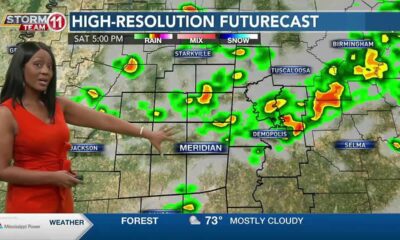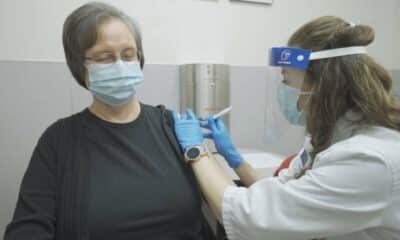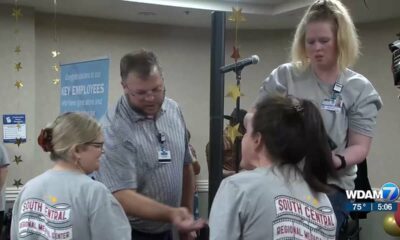Kaiser Health News
E-Cigs Are Still Flooding the US, Addicting Teens With Higher Nicotine Doses
by Liz Szabo, KFF Health News
Mon, 26 Jun 2023 09:00:00 +0000
When the FDA first asserted the authority to regulate e-cigarettes in 2016, many people assumed the agency would quickly get rid of vapes with flavors like cotton candy, gummy bears, and Froot Loops that appeal to kids.
Instead, the FDA allowed all e-cigarettes already on the market to stay while their manufacturers applied for the OK to market them.
Seven years later, vaping has ballooned into an $8.2 billion industry, and manufacturers are flooding the market with thousands of products — most sold illegally and without FDA permission — that can be far more addictive.
“The FDA has failed to protect public health,” said Eric Lindblom, a former senior adviser to the director of the FDA's Center for Tobacco Products. “It's a tragedy.”
Yet the FDA isn't the only entity that has tolerated the selling of vapes to kids.
Multiple players in and out of Washington have declined to act, tied the agency's hands, or neglected to provide the FDA with needed resources. Former Presidents Barack Obama and Donald Trump both have prevented the FDA from broadly banning candy-flavored vapes.
Meanwhile, today's vapes have become “bigger, badder, and cheaper” than older models, said Robin Koval, CEO of the Truth Initiative, a tobacco control advocacy group. The enormous amount of nicotine in e-cigarettes — up 76% over five years — can addict kids in a matter of days, Koval said.
E-cigarettes in the U.S. now contain nicotine concentrations that are, on average, more than twice the level allowed in Canada and Europe. The U.S. sets no limits on the nicotine content of any tobacco product.
“We've never delivered this level of nicotine before,” said Matthew Myers, president of the Campaign for Tobacco-Free Kids, which opposes youth vaping. “We really don't know the long-term health implications.”
Elijah Stone was 19 when he tried his first e-cigarette at a party. He was a college freshman, grappling with depression and attention-deficit/hyperactivity disorder, and “looking for an escape.” Store clerks never asked for his ID.
Stone said he was “hooked instantly.”
“The moment I felt that buzz, how was I supposed to go back after I felt that?” asked Stone, now 23, of Los Angeles.
The e-cigarette industry maintains that higher nicotine concentrations can help adults who smoke heavily switch from combustible cigarettes to vaping products, which are relatively less harmful to them. The FDA has approved high-nicotine, tobacco-flavored e-cigarettes for that purpose, said April Meyers, CEO of the Smoke-Free Alternatives Trade Association.
“The goal is to get people away from combustible products,” said Nicholas Minas Alfaro, CEO of Puff Bar, one of the most popular brands with kids last year. Yet Alfaro acknowledged, “These products are addictive products; there's no hiding that.”
Although e-cigarettes don't produce tar, they do contain harmful chemicals, such as nicotine and formaldehyde. The U.S. Surgeon General has warned that vaping poses significant risks: including damage to the heart, lungs, and parts of the brain that control attention and learning, as well as an increased risk of addiction to other substances.
More than 2.5 million kids used e-cigarettes in 2022, including 14% of high school students, according to the Centers for Disease Control and Prevention.
Most U.S. teen vapers begin puffing within an hour of waking up, according to a survey of e-cigarette users ages 16 to 19 presented at the Society for Research on Nicotine and Tobacco in March.
The potential for profits — and lax enforcement of vaping laws — has led to a gold rush. The number of unique vaping products, as measured by their bar codes, quadrupled in just one year, rising from 453 in June 2021 to 2,023 in June 2022, according to a Truth Initiative review of U.S. retail sales data.
FDA officials say they've been overwhelmed by the volume of e-cigarette marketing applications — 26 million in all.
“There is no regulatory agency in the world that has had to deal with a volume like that,” said Brian King, who became director of the FDA's Center for Tobacco Products in July 2022.
The agency has struggled to stop e-cigarette makers who continue selling vapes despite the FDA's rejection of the products, as well as manufacturers who never bothered to apply for authorization, and counterfeiters hoping to earn as much money as possible before being shut down.
In 2018, public health groups sued the agency, charging that the delay in reviewing applications put kids at risk. Although a court ordered the FDA to finish the job by September 2021, the FDA missed that deadline. An estimated 1.2 million people under the legal age of 21 began vaping over the next year, according to a study published in May in the American Journal of Preventive Medicine.
Recently, the FDA announced it has made decisions on 99% of e-cigarette applications, noting that it had rejected millions and authorized 23. All authorized products have traditional tobacco flavors, and were deemed “appropriate for the protection of public health” because tobacco-flavored products aren't popular with children but provide adult smokers with a less dangerous alternative, King said.
The agency has yet to make final decisions on the most popular products on the market. Those applications are longer and need more careful scientific review, said Mitch Zeller, former director of the FDA's Center for Tobacco Products and a current advisory board member for Qnovia, which is developing smoking-cessation products.
The FDA said it would not complete reviewing applications by the end of June, as it previously forecast, but would need until the end of the year.
Before the FDA can announce new tobacco policies, it needs approval from the president — who doesn't always agree with the FDA's priorities.
For example, Obama rejected FDA officials' proposal to ban kid-friendly flavors in 2016.
And in 2020, Trump backpedaled on his own plan to pull most flavored vapes off the market. Instead of banning all fruit and minty flavors, the Trump administration banned them only in “cartridge-based” devices such as Juul. The flavor ban didn't affect vapes without cartridges, such as disposable e-cigarettes.
The result was predictable, Zeller said.
Teens switched in droves from Juul to brands that weren't affected by the ban, including disposable vapes such as Puff Bar, which were allowed to continue selling candy-flavored vapes.
After receiving its own warning letter from the FDA last year, Puff Bar now sells only zero-nicotine vapes, Alfaro said.
When the FDA does attempt bold action, legal challenges often force it to halt or even reverse course.
The FDA ordered Juul to remove its products from the market in June 2022, for example, but was immediately hit with a lawsuit. The U.S. Court of Appeals for the D.C. Circuit sided with Juul and issued a temporary stay on the FDA's order. Within weeks, the FDA announced it would hold off on enforcing its order because of “scientific issues unique to the JUUL application that warrant additional review.”
E-cigarette makers Logic and R.J. Reynolds Vapor Co. both sued the FDA after the agency ordered them to stop selling menthol vapes, a flavor popular with teens. In both cases, court-imposed stays halted the FDA's orders pending review and the companies' menthol products remain on the market.
Luis Pinto, a spokesperson for parent company Reynolds American, said, “We remain confident in the quality of all of Reynolds' applications, and we believe that there is ample evidence for FDA to determine that the marketing of these products is appropriate for the protection of public health.”
Under the Biden administration, the FDA has begun to step up enforcement efforts. It fined 12 e-cigarette manufacturers more than $19,000 each, and has issued more than 1,500 warning letters to manufacturers. The FDA also issued warnings to 120,000 retailers for selling illegal products or selling to customers under 21, King said. Five of the companies that received warning letters made vapes decorated with cartoon characters, such as Minions, or were shaped like toys, including Nintendo Game Boys or walkie-talkies.
In May, the FDA put Elfbar and other unauthorized vapes from China on its “red list,” which allows FDA agents to detain shipments without inspection at the border. On June 22, the FDA announced it has issued warning letters to an additional 189 retailers for selling unauthorized tobacco products, specifically Elfbar and Esco Bars products, noting that both brands are disposable e-cigarettes that come in flavors known to appeal to youth, including bubblegum and pink lemonade.
In October, the Justice Department for the first time filed lawsuits against six e-cigarette manufacturers on behalf of the FDA, seeking “to stop the illegal manufacture and sale of unauthorized vaping products.”
Some lawmakers say the Justice Department should play a larger role in prosecuting companies selling kid-friendly e-cigarettes.
“Make no mistake: There are more than six e-cigarette manufacturers selling without authorization on the market,” Sen. Dick Durbin (D-Ill.) said in a March letter. Children are “vaping with unauthorized products that are on store shelves only because FDA has seemingly granted these illegal e-cigarettes a free pass.”
By: Liz Szabo, KFF Health News
Title: E-Cigs Are Still Flooding the US, Addicting Teens With Higher Nicotine Doses
Sourced From: kffhealthnews.org/news/article/e-cigs-are-still-flooding-the-us-addicting-teens-with-higher-nicotine-doses/
Published Date: Mon, 26 Jun 2023 09:00:00 +0000
Did you miss our previous article…
https://www.biloxinewsevents.com/were-not-doing-that-why-a-black-couple-wouldnt-crowdfund-to-pay-off-medical-debts/
Kaiser Health News
The Lure of Specialty Medicine Pulls Nurse Practitioners From Primary Care
Michelle Andrews
Fri, 17 May 2024 09:00:00 +0000
For many patients, seeing a nurse practitioner has become a routine part of primary care, in which these “NPs” often perform the same tasks that patients have relied on doctors for.
But NPs in specialty care? That's not routine, at least not yet. Increasingly, though, nurse practitioners and physician assistants are joining cardiology, dermatology, and other specialty practices, broadening their skills and increasing their income.
This development worries some people who track the health workforce, because current trends suggest primary care, which has counted on nurse practitioners to backstop physician shortages, soon might not be able to rely on them to the same extent.
“They're succumbing to the same challenges that we have with physicians,” said Atul Grover, executive director of the Research and Action Institute at the Association of American Medical Colleges. The rates NPs can command in a specialty practice “are quite a bit higher” than practice salaries in primary care, he said.
When nurse practitioner programs began to proliferate in the 1970s, “at first it looked great, producing all these nurse practitioners that go to work with primary care physicians,” said Yalda Jabbarpour, director of the American Academy of Family Physicians' Robert Graham Center for Policy Studies. “But now only 30% are going into primary care.”
Jabbarpour was referring to the 2024 primary care scorecard by the Milbank Memorial Fund, which found that from 2016 to 2021 the proportion of nurse practitioners who worked in primary care practices hovered between 32% and 34%, even though their numbers grew rapidly. The proportion of physician assistants, also known as physician associates, in primary care ranged from 27% to 30%, the study found.
Both nurse practitioners and physician assistants are advanced practice clinicians who, in addition to graduate degrees, must complete distinct education, training, and certification steps. NPs can practice without a doctor's supervision in more than two dozen states, while PAs have similar independence in only a handful of states.
About 88% of nurse practitioners are certified in an area of primary care, according to the American Association of Nurse Practitioners. But it is difficult to track exactly how many work in primary care or in specialty practices. Unlike physicians, they're generally not required to be endorsed by a national standard-setting body to practice in specialties like oncology or cardiology, for example. The AANP declined to answer questions about its annual workforce survey or the extent to which primary care NPs are moving toward specialties.
Though data tracking the change is sparse, specialty practices are adding these advanced practice clinicians at almost the same rate as primary care practices, according to frequently cited research published in 2018.
The clearest evidence of the shift: From 2008 to 2016, there was a 22% increase in the number of specialty practices that employed nurse practitioners and physician assistants, according to that study. The increase in the number of primary care practices that employed these professionals was 24%.
Once more, the most recent projections by the Association of American Medical Colleges predict a dearth of at least 20,200 primary care physicians by 2036. There will also be a shortfall of non-primary care specialists, including a deficiency of at least 10,100 surgical physicians and up to 25,000 physicians in other specialties.
When it comes to the actual work performed, the lines between primary and specialty care are often blurred, said Candice Chen, associate professor of health policy and management at George Washington University.
“You might be a nurse practitioner working in a gastroenterology clinic or cardiology clinic, but the scope of what you do is starting to overlap with primary care,” she said.
Nurse practitioners' salaries vary widely by location, type of facility, and experience. Still, according to data from health care recruiter AMN Healthcare Physician Solutions, formerly known as Merritt Hawkins, the total annual average starting compensation, including signing bonus, for nurse practitioners and physician assistants in specialty practice was $172,544 in the year that ended March 31, slightly higher than the $166,544 for those in primary care.
According to forecasts from the federal Bureau of Labor Statistics, nurse practitioner jobs will increase faster than jobs in almost any other occupation in the decade leading up to 2032, growing by 123,600 jobs or 45%. (Wind turbine service technician is the only other occupation projected to grow as fast.) The growth rate for physician assistants is also much faster than average, at 27%. There are more than twice as many nurse practitioners as physician assistants, however: 323,900 versus 148,000, in 2022.
To Grover, of the AAMC, numbers like this signal that there will probably be enough NPs, PAs, and physicians to meet primary care needs. At the same time, “expect more NPs and PAs to also flow out into other specialties,” he said.
When Pamela Ograbisz started working as a registered nurse 27 years ago, she worked in a cardiothoracic intensive care unit. After she became a family nurse practitioner a few years later, she found a job with a similar specialty practice, which trained her to take on a bigger role, first running their outpatient clinic, then working on the floor, and later in the intensive care unit.
If nurse practitioners want to specialize, often “the doctors mentor them just like they would with a physician residency,” said Ograbisz, now vice president of clinical operations at temporary placement recruiter LocumTenens.com.
If physician assistants want to specialize, they also can do so through mentoring, or they can receive “certificates of added qualifications” in 10 specialties to demonstrate their expertise. Most employers don't “encourage or require” these certificates, however, said Jennifer Orozco, chief medical officer at the American Academy of Physician Associates.
There are a number of training programs for family nurse practitioners who want to develop skills in other areas.
Raina Hoebelheinrich, 40, a family nurse practitioner at a regional medical center in Yankton, South Dakota, recently enrolled in a three-semester post-master's endocrinology training program at Mount Marty University. She lives on a farm in nearby northeastern Nebraska with her husband and five sons.
Hoebelheinrich's new skills could be helpful in her current hospital job, in which she sees a lot of patients with acute diabetes, or in a clinic setting like the one in Sioux Falls, South Dakota, where she is doing her clinical endocrinology training.
Lack of access to endocrinology care in rural areas is a real problem, and many people may travel hundreds of miles to see a specialist.
“There aren't a lot of options,” she said.
——————————
By: Michelle Andrews
Title: The Lure of Specialty Medicine Pulls Nurse Practitioners From Primary Care
Sourced From: kffhealthnews.org/news/article/nurse-practitioners-trend-primary-care-specialties/
Published Date: Fri, 17 May 2024 09:00:00 +0000
Did you miss our previous article…
https://www.biloxinewsevents.com/clean-needles-save-lives-in-some-states-they-might-not-be-legal/
Kaiser Health News
Clean Needles Save Lives. In Some States, They Might Not Be Legal.
Ed Mahon, Spotlight PA and Sarah Boden, WESA
Fri, 17 May 2024 09:00:00 +0000
Kim Botteicher hardly thinks of herself as a criminal.
On the main floor of a former Catholic church in Bolivar, Pennsylvania, Botteicher runs a flower shop and cafe.
In the former church's basement, she also operates a nonprofit organization focused on helping people caught up in the drug epidemic get back on their feet.
The nonprofit, FAVOR ~ Western PA, sits in a rural pocket of the Allegheny Mountains east of Pittsburgh. Her organization's home county of Westmoreland has seen roughly 100 or more drug overdose deaths each year for the past several years, the majority involving fentanyl.
Thousands more residents in the region have been touched by the scourge of addiction, which is where Botteicher comes in.
She helps people find housing, jobs, and health care, and works with families by running support groups and explaining that substance use disorder is a disease, not a moral failing.
But she has also talked publicly about how she has made sterile syringes available to people who use drugs.
“When that person comes in the door,” she said, “if they are covered with abscesses because they have been using needles that are dirty, or they've been sharing needles — maybe they've got hep C — we see that as, ‘OK, this is our first step.'”
Studies have identified public health benefits associated with syringe exchange services. The Centers for Disease Control and Prevention says these programs reduce HIV and hepatitis C infections, and that new users of the programs are more likely to enter drug treatment and more likely to stop using drugs than nonparticipants.
This harm-reduction strategy is supported by leading health groups, such as the American Medical Association, the World Health Organization, and the International AIDS Society.
But providing clean syringes could put Botteicher in legal danger. Under Pennsylvania law, it's a misdemeanor to distribute drug paraphernalia. The state's definition includes hypodermic syringes, needles, and other objects used for injecting banned drugs. Pennsylvania is one of 12 states that do not implicitly or explicitly authorize syringe services programs through statute or regulation, according to a 2023 analysis. A few of those states, but not Pennsylvania, either don't have a state drug paraphernalia law or don't include syringes in it.
Those working on the front lines of the opioid epidemic, like Botteicher, say a reexamination of Pennsylvania's law is long overdue.
There's an urgency to the issue as well: Billions of dollars have begun flowing into Pennsylvania and other states from legal settlements with companies over their role in the opioid epidemic, and syringe services are among the eligible interventions that could be supported by that money.
The opioid settlements reached between drug companies and distributors and a coalition of state attorneys general included a list of recommendations for spending the money. Expanding syringe services is listed as one of the core strategies.
But in Pennsylvania, where 5,158 people died from a drug overdose in 2022, the state's drug paraphernalia law stands in the way.
Concerns over Botteicher's work with syringe services recently led Westmoreland County officials to cancel an allocation of $150,000 in opioid settlement funds they had previously approved for her organization. County Commissioner Douglas Chew defended the decision by saying the county “is very risk averse.”
Botteicher said her organization had planned to use the money to hire additional recovery specialists, not on syringes. Supporters of syringe services point to the cancellation of funding as evidence of the need to change state law, especially given the recommendations of settlement documents.
“It's just a huge inconsistency,” said Zoe Soslow, who leads overdose prevention work in Pennsylvania for the public health organization Vital Strategies. “It's causing a lot of confusion.”
Though sterile syringes can be purchased from pharmacies without a prescription, handing out free ones to make drug use safer is generally considered illegal — or at least in a legal gray area — in most of the state. In Pennsylvania's two largest cities, Philadelphia and Pittsburgh, officials have used local health powers to provide legal protection to people who operate syringe services programs.
Even so, in Philadelphia, Mayor Cherelle Parker, who took office in January, has made it clear she opposes using opioid settlement money, or any city funds, to pay for the distribution of clean needles, The Philadelphia Inquirer has reported. Parker's position signals a major shift in that city's approach to the opioid epidemic.
On the other side of the state, opioid settlement funds have had a big effect for Prevention Point Pittsburgh, a harm reduction organization. Allegheny County reported spending or committing $325,000 in settlement money as of the end of last year to support the organization's work with sterile syringes and other supplies for safer drug use.
“It was absolutely incredible to not have to fundraise every single dollar for the supplies that go out,” said Prevention Point's executive director, Aaron Arnold. “It takes a lot of energy. It pulls away from actual delivery of services when you're constantly having to find out, ‘Do we have enough money to even purchase the supplies that we want to distribute?'”
In parts of Pennsylvania that lack these legal protections, people sometimes operate underground syringe programs.
The Pennsylvania law banning drug paraphernalia was never intended to apply to syringe services, according to Scott Burris, director of the Center for Public Health Law Research at Temple University. But there have not been court cases in Pennsylvania to clarify the issue, and the failure of the legislature to act creates a chilling effect, he said.
Carla Sofronski, executive director of the Pennsylvania Harm Reduction Network, said she was not aware of anyone having faced criminal charges for operating syringe services in the state, but she noted the threat hangs over people who do and that they are taking a “great risk.”
In 2016, the CDC flagged three Pennsylvania counties — Cambria, Crawford, and Luzerne — among 220 counties nationwide in an assessment of communities potentially vulnerable to the rapid spread of HIV and to new or continuing high rates of hepatitis C infections among people who inject drugs.
Kate Favata, a resident of Luzerne County, said she started using heroin in her late teens and wouldn't be alive today if it weren't for the support and community she found at a syringe services program in Philadelphia.
“It kind of just made me feel like I was in a safe space. And I don't really know if there was like a come-to-God moment or come-to-Jesus moment,” she said. “I just wanted better.”
Favata is now in long-term recovery and works for a medication-assisted treatment program.
At clinics in Cambria and Somerset Counties, Highlands Health provides free or low-cost medical care. Despite the legal risk, the organization has operated a syringe program for several years, while also testing patients for infectious diseases, distributing overdose reversal medication, and offering recovery options.
Rosalie Danchanko, Highlands Health's executive director, said she hopes opioid settlement money can eventually support her organization.
“Why shouldn't that wealth be spread around for all organizations that are working with people affected by the opioid problem?” she asked.
In February, legislation to legalize syringe services in Pennsylvania was approved by a committee and has moved forward. The administration of Gov. Josh Shapiro, a Democrat, supports the legislation. But it faces an uncertain future in the full legislature, in which Democrats have a narrow majority in the House and Republicans control the Senate.
One of the bill's lead sponsors, state Rep. Jim Struzzi, hasn't always supported syringe services. But the Republican from western Pennsylvania said that since his brother died from a drug overdose in 2014, he has come to better understand the nature of addiction.
In the committee vote, nearly all of Struzzi's Republican colleagues opposed the bill. State Rep. Paul Schemel said authorizing the “very instrumentality of abuse” crossed a line for him and “would be enabling an evil.”
After the vote, Struzzi said he wanted to build more bipartisan support. He noted that some of his own skepticism about the programs eased only after he visited Prevention Point Pittsburgh and saw how workers do more than just hand out syringes. These types of programs connect people to resources — overdose reversal medication, wound care, substance use treatment — that can save lives and lead to recovery.
“A lot of these people are … desperate. They're alone. They're afraid. And these programs bring them into someone who cares,” Struzzi said. “And that, to me, is a step in the right direction.”
At her nonprofit in western Pennsylvania, Botteicher is hoping lawmakers take action.
“If it's something that's going to help someone, then why is it illegal?” she said. “It just doesn't make any sense to me.”
This story was co-reported by WESA Public Radio and Spotlight PA, an independent, nonpartisan, and nonprofit newsroom producing investigative and public-service journalism that holds power to account and drives positive change in Pennsylvania.
KFF Health News is a national newsroom that produces in-depth journalism about health issues and is one of the core operating programs at KFF—an independent source of health policy research, polling, and journalism. Learn more about KFF.
USE OUR CONTENT
This story can be republished for free (details).
——————————
By: Ed Mahon, Spotlight PA and Sarah Boden, WESA
Title: Clean Needles Save Lives. In Some States, They Might Not Be Legal.
Sourced From: kffhealthnews.org/news/article/clean-needles-syringe-services-programs-legal-gray-area-risk-pennsylvania/
Published Date: Fri, 17 May 2024 09:00:00 +0000
Kaiser Health News
Watch: John Oliver Dishes on KFF Health News’ Opioid Settlements Series
Fri, 17 May 2024 09:00:00 +0000
Opioid manufacturers, distributors, and retailers are paying tens of billions of dollars in restitution to settle lawsuits related to their role in the nation's overdose epidemic. A recent broadcast of “Last Week Tonight With John Oliver” examined how that money is being spent by state and local governments across the United States.
The segment featured reporting from the KFF Health News series “Payback: Tracking the Opioid Settlement Cash.” You can learn more about the issue and read our collection of articles by Aneri Pattani here.
——————————
Title: Watch: John Oliver Dishes on KFF Health News' Opioid Settlements Series
Sourced From: kffhealthnews.org/news/article/watch-john-oliver-kff-health-news-payback-opioid-settlements-series/
Published Date: Fri, 17 May 2024 09:00:00 +0000
-
SuperTalk FM5 days ago
Martin Lawrence making 3 stops in Mississippi on comedy tour
-
Our Mississippi Home4 days ago
Beat the Heat with Mississippi’s Best Waterparks
-
Our Mississippi Home5 days ago
Charlie’s U-Pik: Opening Soon for the Summer Season
-
Mississippi News Video7 days ago
Local dentists offer free dental care in Amory
-
SuperTalk FM17 hours ago
State auditor cracking down on Mississippians receiving unemployment benefits
-
Mississippi News Video3 days ago
Jackson has a gang problem
-
Kaiser Health News4 days ago
Medicaid ‘Unwinding’ Decried as Biased Against Disabled People
-
Mississippi Today7 days ago
On this day in 1968





































